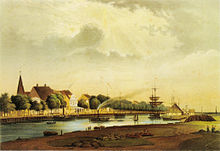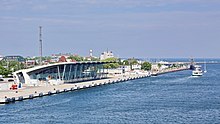Warnemünde
|
Warnemünde
City of Rostock
Coordinates: 54 ° 10 ′ 31 ″ N , 12 ° 5 ′ 18 ″ E
|
|
|---|---|
| Height : | 2 m above sea level NN |
| Area : | 5.9 km² |
| Residents : | 5937 (Dec. 2017) |
| Population density : | 1,006 inhabitants / km² |
| Incorporation : | March 11, 1323 |
| Postal code : | 18119 |
| Area code : | 0381 |
|
Location of Warnemünde in Rostock
|
|
The Ostseebad Warnemünde ( Low German Warnemünn ), officially Seebad Warnemünde , is a district in the north of the Hanseatic city of Rostock in Mecklenburg-Western Pomerania .
The Warnow flows into the Baltic Sea here and gave Warnemünde its name; it was first mentioned in Danish documents in 1195. It has belonged to Rostock since 1323. For centuries Warnemünde was primarily a small port and fishing village, until tourist bathing began around 1821. With its up to 150 meters wide sandy beach, the seaside spa has the widest sandy beach on the German Baltic coast.
Every summer, the Warnemünder Woche and the Hanse Sail take place in the district, each attracting around one million visitors. Warnemünde is also Germany's most important cruise port .
history
In history there was not only Warnemünde west of the Alter Strom. This was not the original Rostock port of the city either, because it was further east. The exact location is not known. The Rostockers received municipal rights to it on October 12, 1264, decades before the princely Warnemünde was incorporated in the west.
On March 11, 1323, the city of Rostock acquired the village of Warnemünde, which was built around 1200, to secure access to the sea. This coastal village at the mouth of the Warnow was an exclave from Rostock until the 18th and 19th centuries . Century a very poor fishing village that benefited little from the wealth of the Hanseatic city. However, the importance of Warnemünde as an important trading point in the north becomes clear in the following: In 1288 the city of Rostock took care of the maintenance of the Warnemünde harbor by signing a contract with the patrician Rötger Horn. This undertook to keep the port entrance at a depth of 12 feet for five years. In return, the city granted him 100,000 bricks and promised to reward him with 400 Mk. Silver or 1,350 Mk. Pfennigs for his work .
According to the building style of the houses on the old Warnemünder Strom, the first residents after the Slavs were the Frisians and Lower Saxony , who settled here from around 1100 and founded the village of Warnemünde. The buildings and the type of houses south of the station bridge have been preserved to this day.
Up until the 19th century, the development was limited to the streets Vöörreeg ( Low German : front row, today Am Strom ) and Achterreeg (Low German: rear row, today Alexandrinenstraße ), both of which were parallel to the (old) river, the former drain of the Warnow into the Baltic Sea , lie. The Vogtei was built in 1605 and is one of the oldest buildings in Warnemünde. In the 19th century Warnemünde gained importance as a seaside resort (first mentioned in 1821) and grew considerably. In 1834 there were already 1,000 bathers for a population of 1,500. Fort Warnemünde was built in 1812 to enforce the continental barrier . From 1889 Warnemünde published its own newspaper.
On June 26, 1886, the railway connection to Rostock and Berlin and the mail steamer connection to Gedser in Denmark were opened , initially with the paddle steamers Kaiser Wilhelm and King Christian . In 1903 the new train station on the other side of the Alter Strom opened and the Warnemünde – Gedser railway ferry , which from 1926 also carried cars. The Hotel Neptun has stood directly on the Baltic Sea beach since 1971 .
Sights and culture
Old / New Stream
On the Alter Strom , the former estuary of the Warnow, there is a fishing port, the hotel "Am Alten Strom" , restaurants, cafes and boutiques. This arm of water, which had existed since 1423, was the shipping connection between the Baltic Sea and the Rostock city port for centuries . In 1903 it was then replaced by the Neuer Strom . About the rotatable railway bridge leads from the town center with its old narrow streets and the church to the station peninsula with the station Warnemünde , the middle pier and the fish market. On the other (east) side of the station peninsula , on the Neuer Strom / Seekanal , a passenger terminal for cruise ships was opened in 2005 , the Warnemünde Cruise Center . The Neue Strom / Seekanal now forms the mouth of the Unterwarnow between the Baltic Sea and Breitling and is the entrance to the ports of Rostock , both to the overseas port and to the chemical port, the cargo and fishing port and the city port.
Buildings

In 1897 Warnemünde received its 37 meter high lighthouse , which is still used today as a navigation mark . Between April and October, tourists can visit the lighthouse and look out over Warnemünde and the Breitling from both viewing platforms .
The Warnemünde tea pot from 1968 is located next to the lighthouse. The tea pot, designed by engineer Ulrich Müther , stands out due to its shell-shaped concrete roof. After ten years of vacancy, it was renovated in 2002 and now houses several restaurants.
The church of Warnemünde was built from 1866 to 1871 in neo-Gothic style on the western edge of the town at the time, because the old, Gothic church had become too small and dilapidated. The previous church stood near the bailiwick . Some of the furnishings, such as the remarkable Gothic carved altar, a statue of St. Christopher and the pulpit were taken over into the new church. An exhibition about former Warnemünde house brands and two votive ships are interesting.
Since September 2005 the right bank of the sea canal at Hohe Düne has been built with a modern marina and an extensive hotel complex. There are two car ferries working in opposite directions.
The Kurhaus Warnemünde on the beach promenade is a restaurant and café building that was built in 1928 in the New Building style.
The Warnemünde Casino was housed in the Warnemünde Kurhaus from 1998 until it was closed in August 2013.
A branch of the Rostock City Library is located in the reading room , west of the spa gardens .
The local museum is housed in a fisherman's house built in 1767. On an area of around 220 m² it offers exhibits and information about the history of fishing and seafaring, piloting and sea rescue , as well as the development of the seaside resort.
The Hotel Neptun is a hotel located on the beach promenade, which was built in 1971 and modernized in the 1990s.
The foundation stone for the Hotel Hübner was laid in Seestrasse 12 as early as 1853 .
The Warnemünde Molenfeuer are two small lighthouses on the Warnemünde west pier (green) and east pier (red).
The design hostel designed by Holzer Kobler Architekturen , Zurich, opened in 2017 and was awarded the German Tourism Prize 2017 . The striking building consists of 63 staggered stacked overseas containers with a total of 188 beds.
Monuments
See the list of architectural monuments in Rostock and the list of monuments, fountains and sculptures in Rostock .
Green areas and parks
The promenade begins at the street Am Leuchtturm . It runs directly behind the dunes and becomes a two-kilometer planetary hiking trail . Along the educational trail , employees of the Rostock observatory have set up astronomical display boards that, starting with the central star, the sun, provide information on all planets in our solar system in the correct scale. The beach of Warnemünde can be entered from the nature trail as well as from the lake promenade via beach entrances. The beach is over three kilometers long, stone-free and becomes narrower and narrower towards the Stoltera cliff .
The spa park is located between the lake promenade and the center of Warnemünde. It was created in 1910. The Kurhausgarten borders the Kurpark with its open-air stage, where concerts regularly take place in summer.
music
Warnemünde is home to many musicians and groups who help shape cultural highlights, such as the shanty choir De Klaashahns , the folk group De Plattfööt , TonArt , Irish Coffee and Heide Mundo .
Events

- The Warnemünde Week is an international sailing event.
- The Hanse Sail takes place annually in the Rostock city harbor and in and in front of Warnemünde.
Education and Research
The Heinrich Heine primary school is located near the lake promenade.
The ecolea | International School is a privately owned grammar school. It is based in Fritz-Reuter-Straße, the former secondary school.
The ecolea | Private vocational school is a state-recognized higher vocational school, where training to become a physiotherapist, paramedic, masseur or medical lifeguard, social assistant and educator can be completed.
The University of Wismar maintains its "Seafaring" division in Warnemünde with the Maritime Simulation Center Warnemünde .
The Leibniz Institute for Baltic Sea Research Warnemünde is a non-university research institute that is dedicated to interdisciplinary marine research in coastal and marginal seas. The focus of the work is on researching the Baltic Sea ecosystem. In the four sections of the IOW, research is carried out on physical oceanography, marine chemistry, biological oceanography and marine geology. The IOW is represented with its own courses at the Universities of Rostock and Greifswald.
The Faculty of Computer Science and Electrical Engineering at the University of Rostock has set up an institute in Warnemünde.
Sports
Due to the low current and the good wind conditions, the sailing area in front of Warnemünde is suitable for kitesurfing , surfing , windsurfing , diving and swimming. Sports activities such as kite flying, Nordic walking , beach volleyball and Ultimate can also be pursued on the beach . In some sports there are international competitions in Warnemünde.
There are three sailing clubs in Warnemünde , the Warnemünde Sailing Club (WSC), the Academic Sailing Club Warnemünde (ASVW) and the Kuttersegelclub Warnemünde (KSC), which among other things promote young sailing talent and are significantly involved in the organization of the Warnemünde Week.
The Warnemünde sports club was founded in 1990. In volleyball, the men play in the 2nd Bundesliga and the women in the regional league. Handball is played with five men's and two women's teams as well as youth teams from the minis to the A-youth. Once a year the Warnemünde Cup takes place with teams from all over Germany. The football department was outsourced to SV Warnemünde football in 1999 ; he plays in the state class Mecklenburg-Western Pomerania.
At the University Sports Association Warnemünde from 1971 with ten sports departments, the water polo division dominates. Today she is based in Lütten Klein .
The frisbee tournament Sun of the Beach is one of the annual highlights on the beach in Warnemünde .
300 athletes from 15 nations have been taking part in the DLRG Cup every year since the mid-1990s , an international open water lifeguard competition. In 2008 the world championship in lifeguarding was held in Warnemünde.
Warnemünder Strand is also used annually for beach volleyball tournaments , such as the two AnBagger Cups and for determining the state rankings of Mecklenburg-Western Pomerania.
Churches
There are three Christian communities in Warnemünde,
- the Evangelical Lutheran parish with the neo-Gothic church of Warnemünde from 1871 in the center,
- the Catholic parish Maria Meeresstern ,
- the New Apostolic Church.
Economy and Transport
economy
The tourism is an important sector in Warnemünde. Fishing was and is also formative for the place.
shipyard
The Warnow shipyard has existed since 1946 and was the GDR 's largest shipbuilding company from 1960 . In 1990 Warnow-Werft Warnemünde GmbH was founded, which, after being taken over by the Kværner Group , traded under the name of Kværner Warnow Werft Rostock GmbH . In the 1990s, the shipyard was comprehensively renovated and large parts of the production facilities were rebuilt. After various company takeovers and an application for bankruptcy in June 2009, Nordic Yards was the owner from 2009 to 2016 ; since 2016 the shipyard has been operating as MV Werften Rostock .
cruise
Cruise ship arrivals are an important economic and tourist factor. In 1990 there were only three arrivals in Warnemünde, a German record was achieved in 2012 with 181 arrivals and 300,000 passengers (single counting) from 40 different cruise ships and 24 international shipping companies . This makes Rostock-Warnemünde the largest cruise port in Germany. In 2013, the record was broken again with 198. The port development company recorded 182 bookings for cruise calls for the 2014 and 2015 seasons and a total of 181 for 2016, and in 2016 766,000 passengers were handled in Warnemünde.
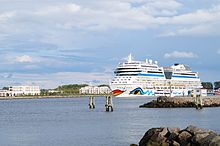
On May 1st, 2005, a new cruise center or cruise terminal was opened in order to be able to handle passengers better. Many passengers of the berthing ships take day trips to Hamburg , Rostock or Berlin . Numerous cruise companies such as Norwegian Cruise Line , Princess Cruises , Costa Crociere and MSC Kreuzfahrten (since 2014) use Warnemünde for a partial passenger change, Carnival Corporation & plc with its brand AIDA Cruises as a base port with full passenger change for Nordland cruises in the summer season.
Aerospace
Rostock-Warnemünde has an important history as a location for the aerospace industry and was one of the most innovative production facilities in the world before the war . The industry has been able to re-establish itself since German reunification in 1990. Several Airbus - suppliers with around 1,000 employees have settled around Warnemünde how the RST Rostock System-Technik GmbH , which opened in 2007 at the Center for Aerospace is the Technology Park Warnemünde. There, the German Aerospace Center (DLR) is also working on the development of the European satellite navigation system Galileo , with the “Sea Gate” project for ship control.
Historically, the Ernst Heinkel Flugzeugwerke was founded in Warnemünde in 1922, one of the largest aircraft manufacturers of the first half of the 20th century. The Heinkel He 178 was the world's first jet aircraft and had its maiden flight on August 27, 1939 over Rostock-Marienehe . Since 1921 there was also the Arado Flugzeugwerke in Warnemünde and from 1923 the Walther-Bachmann-Flugzeugbau .
For the rearmament policy from 1933, most of the companies were expropriated or had to switch to military production. Bachmann-Flugzeugbau therefore also moved to Ribnitz in 1934 . By 1961 at the latest, practically all companies in the industry were expropriated and z. B. converted to agricultural production or completely liquidated .
traffic
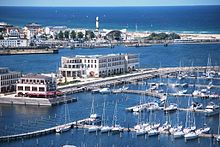
train
Warnemünde has been accessible by train since 1886. The station Warnemünde since 1974, the end point of the S-Bahn Rostock . The railway bridge Warnemünde , a swing bridge from 1903 on the Warnow , connecting as a pedestrian bridge over the old stream away Warnemünde train station on the middle pier and the western center.
bus
The bus lines 36, 37 and F1 of the Rostocker Straßenbahn AG open up the district.
Street
Warnemünde is connected to the federal highway 20 and the neighboring southern districts by the feeder to the federal highway 103 via driveway 14 (Rostock-West) . The state road L12 connects Warnemünde to the west with Bad Doberan . To the east you can take the car ferry over the sea canal to the Hohe Düne district and then take the K43 Markgrafenheide and Hinrichshagen district road . From there you can take the L22 or L221 state roads to the federal road 105 . This is the shortest way to get to the Rostock Heath , the Darss or Stralsund .
bicycle
Warnemünde is connected to the Baltic Sea Cycle Route , which circles the Baltic Sea as one of the European EuroVelo routes.
ship
The Warnemünde Cruise Center was opened in 2005. In 2018, the cruise port recorded over 200 cruise arrivals from 44 ships in Warnemünde and the Rostock overseas port .
Passenger ship
Various shipping companies offer harbor tours and a beach line service between Rostock and Warnemünde.
Personalities
Sons and daughters
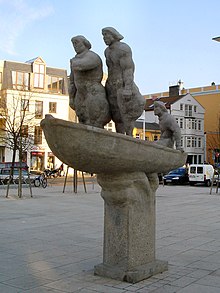
- Stephan Jantzen (1827–1913), seaman, pilot commander and sea rescuer
- Fritz Neumann (1854–1934), Romanist
- Paul Lindemann (1871–1924), third Lord Mayor of Kiel
- Hans Seehase (1887–1974), engineer and inventor
- Hedwig Anke (1902–1983), fish woman, to whose work the symbolic figure Min Herzing goes back
- Werner Schmidt-Boelcke (1903–1985), composer and conductor
- Walter Kröger (1912–1991), aircraft engineer and aviation pioneer
- Karl Heinz Robrahn (1913–1987), poet
- Albrecht Hennings (* 1920), film architect
- Maria-Viktoria Hasse (1921–2014), mathematician
- Horst Köbbert (1928–2014), entertainer, singer and television presenter
- Hartwig Eschenburg (* 1934), church musician
- Norbert Werbs (* 1940), theologian and auxiliary bishop
- Vera Schneidbach (* 1941), singer
- Horst D. Schulz (* 1942), geochemist and hydrogeologist
- Franz-Heinrich Beyer (* 1949), Protestant theologian
- Siegfried Wittenburg (* 1952), photographer and author
- Michael Mücke (* 1953), volleyball trainer
- Kirsten Emmelmann (* 1961), track and field athlete and Olympic medalist
- Michael Niekammer (* 1961), singer, actor, text writer and artist manager
- Simone Tippach-Schneider (* 1962), publicist and exhibition maker
- Nils Busch-Petersen (* 1963), politician and lawyer
- Matthias Hahn (* 1965), handball player
- Jörg Benedict (* 1966), legal scholar
- Wilfried Eisenberg (* 1968), manager
- Anke John (* 1968), historian, professor of history didactics
- Jörn Lenz (* 1969), soccer player
Personalities who work or have worked on site

- Friedrich Flügge (1817–1898), Grand Ducal Mecklenburg Post Office Director, played a major role in establishing the Warnemünde-Gedser ferry connection
- Edvard Munch (1863–1944), Norwegian painter and graphic artist, worked temporarily in Warnemünde
- Gustav Wilhelm Berringer (1880–1953), architect, builder of the Kurhaus
- Walter Butzek (1886–1965), architect, was involved in the construction of the Kurhaus
- Ernst Heinkel (1888–1958), aircraft designer and industrialist
- Karl Eschenburg (1900–1947), photographer
- Gotthilf Hempel (* 1929), marine biologist, was director of the Institute for Baltic Sea Research in Warnemünde from 1992 to 1994
- Ulrich Müther (1934–2007), civil engineer and building contractor, builder of the tea pot
- Klaus Lass (* 1950), musician and singer
- Mathias Rieck (* 1979), athlete
Climate table
| Warnemünde | ||||||||||||||||||||||||||||||||||||||||||||||||
|---|---|---|---|---|---|---|---|---|---|---|---|---|---|---|---|---|---|---|---|---|---|---|---|---|---|---|---|---|---|---|---|---|---|---|---|---|---|---|---|---|---|---|---|---|---|---|---|---|
| Climate diagram | ||||||||||||||||||||||||||||||||||||||||||||||||
| ||||||||||||||||||||||||||||||||||||||||||||||||
|
Average monthly temperatures and precipitation for Warnemünde
Source: wetterkontor.de
|
|||||||||||||||||||||||||||||||||||||||||||||||||||||||||||||||||||||||||||||||||||||||||||||||||||||||||||||||||||||||||||||||||||||||||||||||||||||||||||||||||||||||||||||||||||||||||||||||||||
Web links
- Hanseatic and university town of Rostock - Rostock and Warnemünde tourist office
- Literature about Warnemünde in the state bibliography MV
- Warnemünde portal
Individual evidence
- ↑ Statistics office of the city of Rostock: Population with main residence of the Hanseatic and university city of Rostock by district - as of December 31, 2017
- ↑ See L. Krause: The old Warnow estuaries and the original Rostock port at Warnemünde. In: Contributions to the history of the city of Rostock. Published by the Rostock Antiquities Association. Vol. 12. Rostock 1924, pp. 1-16.
- ^ Old river Warnemünde
- ↑ Sustainable design hostel - overseas containers and hot-dip galvanized steel. In: Hot-dip galvanizing magazine. Retrieved May 11, 2020 .
- ↑ DLRG: Rescue Sports - Invitation Competitions ( Memento from October 19, 2011 in the Internet Archive ) accessed on August 24, 2009
- ↑ Internet presence of the Rescue Sports World Championship 2008 , accessed on August 4, 2014
- ^ Rostock Port GmbH
- ↑ Statistics: Cruise Ship Calls & Passengers , Rostock Port Authority, accessed on December 29, 2016
- ^ Aerospace companies in the Rostock area ( memento of November 10, 2014 in the Internet Archive ), Rostock Business, accessed on November 10, 2014
- ↑ The growth sector of the aerospace supply industry ( memento of June 8, 2013 in the Internet Archive ), Ministry of Economics MV, accessed on November 12, 2014
- ↑ Aerospace research center opened in Warnemünde , airliners.de, November 16, 2007, accessed on November 12, 2014
- ↑ Airbus / RST Rostock-System-Technik GmbH ( Memento from November 12, 2014 in the Internet Archive )
- ↑ Sea Gate: Galileo test area for maritime applications , German Aerospace Center (DLR), accessed on November 12, 2014
- ↑ Heinkel He 178 , fliegerweb.com, accessed on November 10, 2014
- ↑ Baltic Sea Cycle Route. In: auf-nach-mv.de. Retrieved July 12, 2018 .
- ↑ EuroVelo 10. In: eurovelo.com. Retrieved February 14, 2019 .
- ↑ Cruise ships Warnemünde. In: Cruise Pirates. Retrieved June 18, 2019 .
- ↑ Passenger shipping - Rostock - Warnemünde. Retrieved May 12, 2020 .



